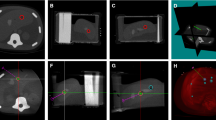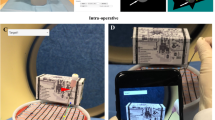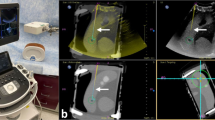Abstract
Purpose
To compare the system accuracy and needle placement performance of smartphone- and smartglasses-based augmented reality (AR) for percutaneous needle interventions.
Methods
An AR platform was developed to enable the superimposition of annotated anatomy and a planned needle trajectory onto a patient in real time. The system accuracy of the AR display on smartphone (iPhone7) and smartglasses (HoloLens1) devices was evaluated on a 3D-printed phantom. The target overlay error was measured as the distance between actual and virtual targets (n = 336) on the AR display, derived from preprocedural CT. The needle overlay angle was measured as the angular difference between actual and virtual needles (n = 12) on the AR display. Three operators each used the iPhone (n = 8), HoloLens (n = 8) and CT-guided freehand (n = 8) to guide needles into targets in a phantom. Needle placement error was measured with post-placement CT. Needle placement time was recorded from needle puncture to navigation completion.
Results
The target overlay error of the iPhone was comparable to the HoloLens (1.75 ± 0.59 mm, 1.74 ± 0.86 mm, respectively, p = 0.9). The needle overlay angle of the iPhone and HoloLens was similar (0.28 ± 0.32°, 0.41 ± 0.23°, respectively, p = 0.26). The iPhone-guided needle placements showed reduced error compared to the HoloLens (2.58 ± 1.04 mm, 3.61 ± 2.25 mm, respectively, p = 0.05) and increased time (87 ± 17 s, 71 ± 27 s, respectively, p = 0.02). Both AR devices reduced placement error compared to CT-guided freehand (15.92 ± 8.06 mm, both p < 0.001).
Conclusion
An augmented reality platform employed on smartphone and smartglasses devices may provide accurate display and navigation guidance for percutaneous needle-based interventions.








Similar content being viewed by others
Availability of data and material
The data that support the findings of this study are available from the corresponding author, ML, upon reasonable request.
References
Appelbaum L, Sosna J, Nissenbaum Y, Benshtein A, Goldberg SN (2011) Electromagnetic navigation system for CT-guided biopsy of small lesions. AJR Am J Roentgenol 196(5):1194–1200. https://doi.org/10.2214/ajr.10.5151
Krücker J, Xu S, Glossop N, Viswanathan A, Borgert J, Schulz HJWB (2007) Electromagnetic tracking for thermal ablation and biopsy guidance: clinical evaluation of spatial accuracy. J Vasc Interv Radiol 18(9):1141–1150. https://doi.org/10.1016/j.jvir.2007.06.014
Kloeppel R, Weisse T, Deckert F, Wilke W, Pecher S (2000) CT-guided intervention using a patient laser marker system. Eur Radiol 10(6):1010–1014. https://doi.org/10.1007/s003300051054
Kettenbach J, Kronreif G (2015) Robotic systems for percutaneous needle-guided interventions. Minim Invasive Ther Allied Technol 24(1):45–53. https://doi.org/10.3109/13645706.2014.977299
Deng W, Li F, Wang M, Song Z (2014) Easy-to-use augmented reality neuronavigation using a wireless tablet PC. Stereotact Funct Neurosurg 1:17–24. https://doi.org/10.1159/000354816
Watanabe E, Satoh M, Konno T, Hirai MTY (2016) The trans-visible navigator: a see-through neuronavigation system using augmented reality. World Neurosurg 87:399–405. https://doi.org/10.1016/j.wneu.2015.11.084
Pratt P, Ives M, Lawton G, Simmons J, Radev N, Spyropoulou L, Amiras D (2018) Through the HoloLens™ looking glass: augmented reality for extremity reconstruction surgery using 3D vascular models with perforating vessels. Eur Radiol Exp. https://doi.org/10.1186/s41747-017-0033-2
Solbiati M, Passera KM, Rotilio A, Oliva F, Marre I, Goldberg SN, Ierace T, Solbiati L (2018) Augmented reality for interventional oncology: proof-of-concept study of a novel high-end guidance system platform. Eur Radiol Exp 2:18. https://doi.org/10.1186/s41747-018-0054-5
Hecht R, Li M, de Ruiter QMB, Pritchard WF, Li X, Krishnasamy V, Saad W, Karanian JW, Wood BJ (2020) Smartphone augmented reality CT-based platform for needle insertion guidance: a phantom study. Cardiovasc Intervent Radiol. https://doi.org/10.1007/s00270-019-02403-6
Park BJ, Hunt SJ, Martin C, Nadolski GJ, Wood BJ, Gade TP (2020) Augmented and mixed reality: technologies for enhancing the future of IR. J Vasc Interv Radiol. https://doi.org/10.1016/j.jvir.2019.09.020
Kuzhagaliyev T, Clancy NT, Janatka M, Tchaka K, Vasconcelos F, Clarkson MJ, Gurusamy K, Hawkes DJ, Davidson B, Stoyanov D (2018) Augmented reality needle ablation guidance tool for irreversible electroporation in the pancreas. In: SPIE Medical Imaging, Houston, Texas, p 1057613. https://doi.org/10.1117/12.2293671
Al-Nimer S, Hanlon A, Cho K, Kalra-Lall A, Weunski C, Yanof J, West K, Martin C 3rd (2020) 3D holographic guidance and navigation for percutaneous ablation of solid tumor. J Vasc Interv Radiol 31(3):526–528. https://doi.org/10.1016/j.jvir.2019.09.027
Heinrich F, Joeres F, Lawonn K, Hansen C (2019) Comparison of projective augmented reality concepts to support medical needle insertion. IEEE Trans Vis Comput Graph. https://doi.org/10.1109/tvcg.2019.2903942
Held RT, Hui TT (2011) A guide to stereoscopic 3D displays in medicine. Acad Radiol 18(8):1035–1048. https://doi.org/10.1016/j.acra.2011.04.005
Condino S, Carbone M, Piazza R, Ferrari M, Ferrari V (2020) Perceptual limits of optical see-through visors for augmented reality guidance of manual tasks. IEEE Trans Biomed Eng 67(2):411–419. https://doi.org/10.1109/TBME.2019.2914517
Grubert J, Itoh Y, Moser K, Swan JE (2018) A survey of calibration methods for optical see-through head-mounted displays. IEEE Trans Vis Comput Graph 24(9):2649–2662. https://doi.org/10.1109/TVCG.2017.2754257
Fichtinger G, Deguet A, Masamune K, Balogh E, Fischer GS, Mathieu H, Taylor RH, Zinreich SJ, Fayad LM (2005) Image overlay guidance for needle insertion in CT scanner. IEEE Trans Biomed Eng 52(8):1415–1424. https://doi.org/10.1109/tbme.2005.851493
Racadio JM, Nachabe R, Homan R, Schierling R, Racadio JM, Babic D (2016) Augmented reality on a C-Arm system: a preclinical assessment for percutaneous needle localization. Radiology 281(1):249–255. https://doi.org/10.1148/radiol.2016151040
Vovk A, Wild F, Guest W, Kuula T (2018) Simulator sickness in augmented reality training using the Microsoft HoloLens. In: CHI Conf. Hum. Factors Comput. Syst., Montreal QC, Canada, ACM, pp 1–9. https://doi.org/10.1145/3173574.3173783
Hua H, Javidi B (2014) 3D integral imaging optical see-through head-mounted display. Opt Express 22(11):13484–13491. https://doi.org/10.1364/OE.22.013484
Lanman D, Luebke D (2013) Near-eye light field displays. ACM Trans Graph. https://doi.org/10.1145/2508363.2508366
Singh G, Ellis SR, Swan JE II (2018) The effect of focal distance, age, and brightness on near-field augmented reality depth matching. J IEEE Trans Vis Comput Graph. https://doi.org/10.1109/TVCG.2018.2869729
Rosenthal M, State A, Lee J, Hirota G, Ackerman J, Keller K, Pisano E, Jiroutek M, Muller K, Fuchs H (2002) Augmented reality guidance for needle biopsies: an initial randomized, controlled trial in phantoms. Med Image Anal 6(3):313–320
Wacker FK, Vogt S, Khamene A, Jesberger JA, Nour SG, Elgort DR, Sauer F, Duerk JL, Lewin JS (2006) An augmented reality system for MR image-guided needle biopsy: initial results in a swine model. Radiology 238(2):497–504. https://doi.org/10.1148/radiol.2382041441
Acknowledgements
This research was supported by the Intramural Research Program of the NIH Center for Interventional Oncology.
Funding
This work was supported by the Center for Interventional Oncology in the Intramural Research Program of the National Institutes of Health (NIH) by intramural NIH Grants NIH Z01 1ZID BC011242 and CL040015.
Author information
Authors and Affiliations
Corresponding author
Ethics declarations
Conflicts of interest
This research was supported in part by the Center for Interventional Oncology and the Intramural Research Program of the NIH. NV is an employee of Philips Research North America, Cambridge, MA, USA.
Code availability
The code that support the findings of this study are available from the corresponding author, ML, upon reasonable request.
Additional information
Publisher's Note
Springer Nature remains neutral with regard to jurisdictional claims in published maps and institutional affiliations.
Rights and permissions
About this article
Cite this article
Li, M., Seifabadi, R., Long, D. et al. Smartphone- versus smartglasses-based augmented reality (AR) for percutaneous needle interventions: system accuracy and feasibility study. Int J CARS 15, 1921–1930 (2020). https://doi.org/10.1007/s11548-020-02235-7
Received:
Accepted:
Published:
Issue Date:
DOI: https://doi.org/10.1007/s11548-020-02235-7




